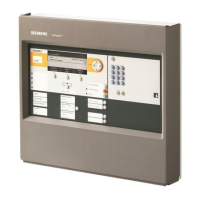
Do you have a question about the Siemens FC7xx and is the answer not in the manual?
| Brand | Siemens |
|---|---|
| Model | FC7xx |
| Category | Control Panel |
| Language | English |
Details important safety notices, danger symbols, and signal words for safe operation.
Outlines national standards, legislation, and electrical installation safety regulations.
Describes the integrated Person Machine Interface (PMI) for operating the fire detection system.
Describes the PMI with the Fire brigade panel (FBP) for fire detection system operation.
Explains the function and dynamic assignment of softkeys for carrying out operations.
Describes the Cerberus-Remote software for PC access to the PMI and its features.
Explains the Cerberus Mobile app for smartphones used to display or operate the station.
Explains how to select list items and execute commands using various buttons and methods.
Details the 'Limited access (view only)' and 'Full access (view/operation)' modes for Cerberus-Remote.
Explains the 'Limited access (view only)' and 'Full access (view/operation)' modes for Cerberus Mobile.
Details the step-by-step procedure to follow in case of an alarm event.
Explains the ALARM procedure specifically for the PMI with FBP [AU].
Outlines the steps to take when a fault occurs in the system.
Describes how to switch system parts off for maintenance or other reasons.
Details the process for switching individual detector zones on or off.
Explains how to switch individual detectors on or off.
Details how to switch the remote transmission for fire alarms on or off.
Explains how to log in, change access levels using PIN or key switch.
Explains how to switch between Manned and Unmanned operation modes.
Introduces the basic methods for entering commands: function-oriented and object-oriented.
Describes how to select elements or events for detailed indication, configuration, or command entry.
Covers various testing procedures for detectors, installations, and controls.
Describes the hardware function test for detectors and their assignment to the detection tree.
Explains the installation test for the entire fire detection installation, including controls and alarming.
Covers activating, deactivating, and resetting outputs and controls.
Details how to deactivate and reactivate alarm devices from the PMI.
Describes the process of activating a zone, which generates an ALARM event.
Explains how to activate or deactivate fire control functions for dampers, fans, etc.
Details how to configure evacuation functions for alarm device zones.
Explains how to enter configuration settings for operation modes, times, and customer text.
Describes the function to commission a newly installed station without additional settings.
Details how to enable or disable Cerberus-Remote access for station viewing and operation.
Explains how to establish a connection to a station using Cerberus-Remote via local or GAP.
Details how to specify the operation mode (view only or full access) for Cerberus Mobile.
Explains how to poll and delete event memory data, either on the station or PC.
Details the different operation modes: Normal, Test, Isolation, and Renovation.
Describes normal operation, including Manned and Unmanned modes and their implications.
Explains how to switch off zones for special situations and the 'ISOLATION' condition.
Describes normal operation, including Manned and Unmanned modes and their implications.
Covers various testing procedures including detector tests, installation tests, and control tests.
Describes the hardware function test for detectors and their assignment to the detection tree.
Explains the installation test for the entire fire detection installation, including controls and alarming.
Explains how to switch off zones for special situations and the 'ISOLATION' condition.
Explains the different access levels, rights, and how they protect the station from unauthorized operation.
Lists commands for switching elements on/off, including required access levels.
Details commands related to testing, such as detector tests and installation tests, with access levels.
Lists commands for activating and deactivating various system functions with access levels.
Lists commands related to configuring system parameters and settings.
Details commands for system maintenance tasks like resets, updates, and device management.
Describes the structure trees (Hardware, Detection, Control, Operation, Network) of the fire detection installation.
Illustrates geographic and functional conditions, adapted to building structure and room use.
Represents controls and grouping units for configuration and operation in the fire detection system.
Explains how detectors acquire fire phenomena and transmit danger levels to the zone.
Describes how danger levels are evaluated in zones to decide whether to trigger an ALARM.
Explains how the fire control unit alerts people and initiates actions based on event categories.
Details automatic measures initiated during a fire, like closing dampers and switching off fans.
Explains how to configure evacuation functions for alarm device zones with Alert and Evac.
Explains how fire and smoke dampers are actuated and controlled via C-NET modules.
Explains the concept of delayed alarm transmission considering operating personnel interaction.
Describes the attendance check process for immediate intervention and global alarming.
Details the time allocated for personnel to examine alarm sources and causes.
Explains how alarming is controlled at the 'Area' level, including alarm devices and remote transmission.
Explains how events are classified and evaluated to activate alarming equipment.
Describes attendance check for immediate intervention and handling of technical deficiencies.
Details how alarming equipment and remote transmission can be configured for Manned/Unmanned operations.
Lists common faults, their causes, and remedies for automatic detectors and manual call points.
Details actions required for mains failure and explains emergency power supply.
Instructs to check and replace fuses if they are damaged.
Provides a recommended maintenance schedule for testing detectors, panels, and simulating faults.
Explains the concept for preventing false alarms by considering operator interaction.
Abbreviation for 'Alarm Verification Concept'.
Diagram of geographical and organizational sensor arrangements in a building.
Control that manages connected extinguishing systems and evaluates their states.
Control activated in the event of a fire alarm.
Concept with two independent verifications for intervention and servicing measures.